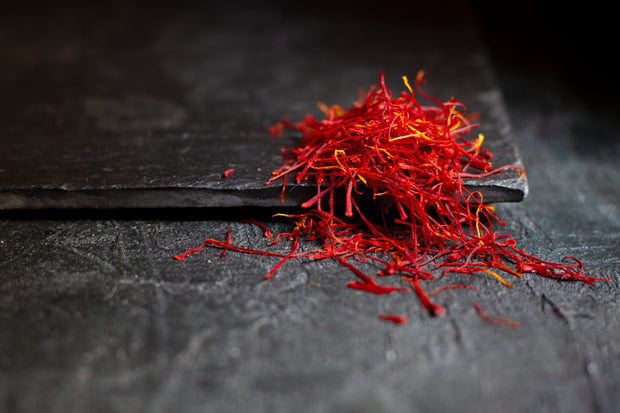Saffron Cultivation & Harvesting: The Complete Guide from Planting to Drying 
Cultivation of saffron – the basis for high-quality spice
Saffron thrives in warm, dry climates with little rainfall. The plant prefers well-aerated, permeable soils with a neutral to slightly alkaline pH (6–8). The choice of location is crucial for successful saffron cultivation.
Planting time and preparation
The saffron corms are planted between July and September – ideal for flowering in the fall. The soil is dug deeply and fertilized with organic fertilizer (e.g., sulfur). The soil is enriched and loosened with organic matter (e.g., compost or manure). Drip irrigation helps ensure even moisture distribution.
Growth conditions
Saffron loves sun—the more light, the better the flowering. The location should be sheltered from the wind but open. Avoid waterlogging, as this promotes fungal diseases.
Vegetation cycle – the year-round life rhythm of the plant
Saffron has an unusual vegetation cycle:
- Autumn: purple saffron blossom appears
- Winter: formation of leaves, photosynthesis
- Spring: Retreat into the tuber
- Summer: Rest period (no water required)
Flowering time – When the plant shows its valuable stigmas
In October or November, the purple saffron blossoms open for a few days. Each blossom contains exactly three red stigmas – these are the precious saffron threads.
Harvest time
The saffron harvest begins early in the morning, when the flowers are still closed. This preserves the full aroma. The stigmas quickly lose their quality, so quick action is required.
Harvest – handcrafted for the highest quality
The harvest is done entirely by hand. Each individual blossom is carefully picked. The red stigmas ( saffron threads ) are then removed – a process known as "roasting" the blossom.
Did you know?
For 1 kg of dried saffron, around 200,000 flowers are needed – which explains the high price of the spice.
Drying – The process that preserves the flavor
Immediately after harvesting, the saffron threads are dried – traditionally over a light coal or wood fire, today often in drying ovens at 35–45 ° C. Even , slow drying is important.
Drying instructions
- Place threads on tissue paper
- At low heat (e.g. oven with door slightly open)
- 20–30 minutes until the threads crackle
Storage and quality assurance
Dried saffron is stored in a light- and airtight container – e.g. B. in glass containers . Stored in a cool , dry place, saffron retains its quality for up to two years.
Challenges in saffron cultivation
Although saffron appears robust, it is sensitive to:
- Waterlogging → fungal infestation
- Nematodes → root destruction
- Field mice → eat tubers
Modern innovations – efficiency in saffron cultivation
New technologies help with sustainable saffron cultivation:
- Drip irrigation
- Sensors for soil monitoring
- mobile drying units
- mechanized sorting of threads
Conclusion
Growing saffron is demanding but rewarding work. Every step—from planting to harvesting to drying—is crucial for quality. Thanks to modern technology, high-quality saffron can be successfully cultivated even outside of traditional regions.
Frequently asked questions about saffron cultivation and harvesting (FAQ)
1. What is the difference between organic and non-organic saffron bulbs?
Organic saffron bulbs are grown without the use of chemical fertilizers and pesticides and are usually certified accordingly. Non-organic bulbs may be grown using chemicals but are often produced using sustainable agricultural methods.
2. How many saffron flowers are needed to produce one gram of dried saffron?
To obtain one gram of dried saffron, about 150 to 180 saffron flowers are needed.
3. Can saffron be grown in a pot or in the home garden?
Yes, saffron can be grown in a pot or in the home garden, provided the location is sunny and the soil has good drainage.
4. When is the best time to plant saffron bulbs?
The best time to plant saffron bulbs is from late summer to early autumn, typically from July to September.
5. How often should saffron bulbs be replanted?
It is recommended to transplant the saffron bulbs to a new location every 3 to 5 years to prevent loss of quality and soil diseases.
6. How do you dry and store saffron properly?
After harvesting, the saffron threads should be dried at low temperatures in a dry environment. For storage, they should be kept in airtight glass containers in a cool, dark place.
7. Is saffron frost-resistant?
Yes, saffron can withstand temperatures down to -10 degrees Celsius, but should be protected from strong cold winds and severe frosts.
8. What type of soil is suitable for saffron cultivation?
Light, sandy and well-drained soils with a pH between 6 and 8 are ideal for saffron cultivation.
9. Is saffron cultivation possible in Germany?
Yes, saffron cultivation is possible in regions of Germany with warm summers and mild winters, such as some southern areas.
10. Can saffron be propagated from seeds?
No, saffron is not propagated from seed. Propagation occurs by dividing the bulbs (corms).
For more information about saffron
Chemical composition of saffron
How do you recognize real saffron?




